Text
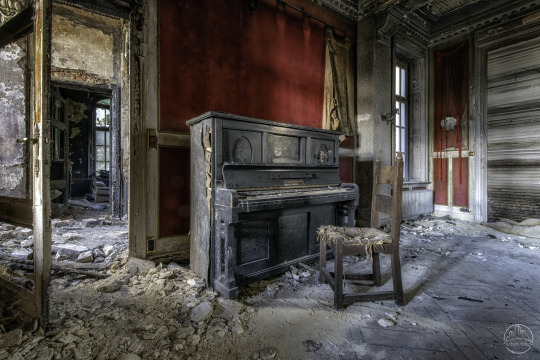
CHATEAU INCENSA
Nothing is known about the history of this cute chateau, or rather country house. The building was hit by a raging fire, which destroyed pretty much the entire interior. The top floors are even no longer accessible, since all the wooden staircases were burnt. In the middle of the inferno was this beautiful piano, which miraculously managed to escape the flames, but which was damaged by the fire extinguishing water.
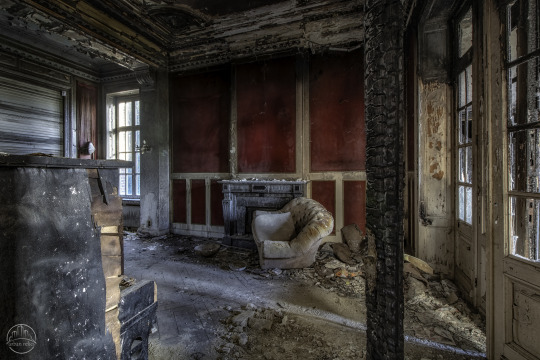



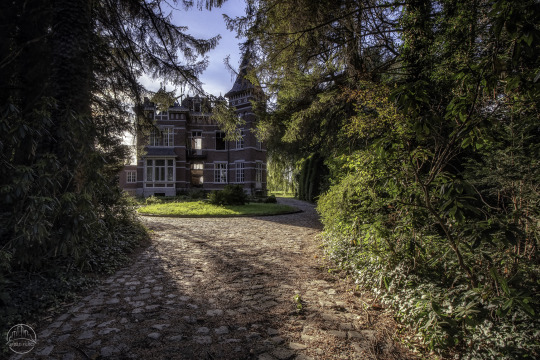
#urban exploration#urbex#abandoned#urban relics#decay#derelict#abandoned places#ue#photography#urbanexploration#abandoned addiction#abandoned house#abandoned buildings#urbexworld#urbexplaces#lost places#urbexpeople#urbexphotography#belgium
34 notes
·
View notes
Text
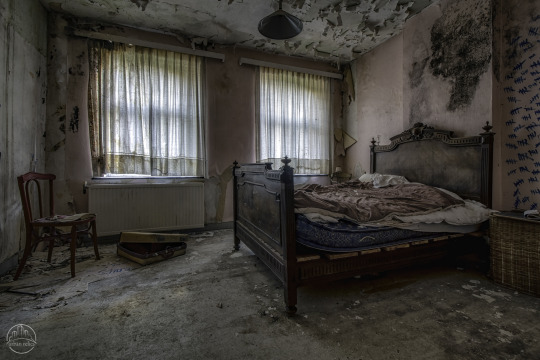
HOTEL WARRE
On the edge of the center of one of the most touristic towns in the Belgian Ardennes, we found this abandoned hotel. The building is not a classified heritage site and is not an architectural heritage. So there is absolutely nothing to be found about its history...




The "problem" with these types of locations (and also the reason why I usually avoid them) is that heaps of left-behind stuff encourage some people to create "pretty scenes". These staged scenes are abundant here, which makes the location rather uninteresting.
The hotel was on our way back from France, where we spent a day admiring abandoned industrial heritage. To end the day we made a quick stop here and, after some hesitation, decided to take a few pictures, since we were already there anyway...

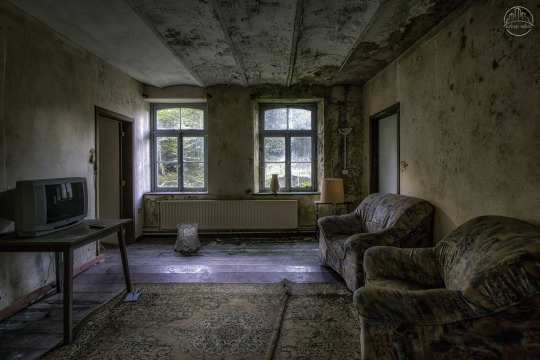

#urban exploration#urbex#abandoned#urban relics#decay#derelict#abandoned places#ue#photography#urbanexploration#urbexworld#urbexplaces#urbexphotography#lost places#abandoned addiction#abandoned buildings#hotel#warre#belgium
44 notes
·
View notes
Text
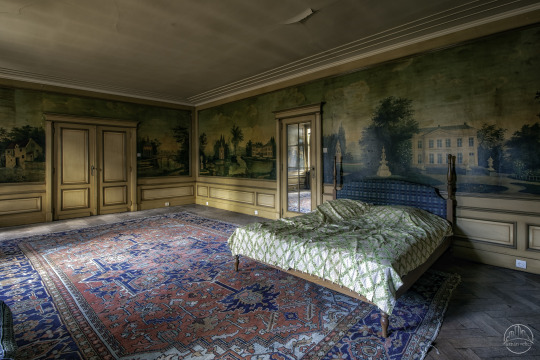
VILLA DOCTEUR
As the title already suggests, this visit concerns the once beautiful, but now abandoned and dilapidated villa of a former doctor... Especially the large salon, with the lush Persian carpet and the beautiful classical murals, appeals to the imagination.

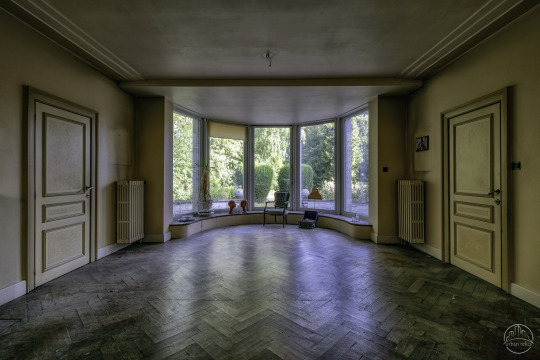
The villa - where, miraculously, water and electricity still work - shows very little signs to the former doctor's practice. Only on the landing an old chest, filled to the brim with prescription booklets, reveals the profession of the former resident.
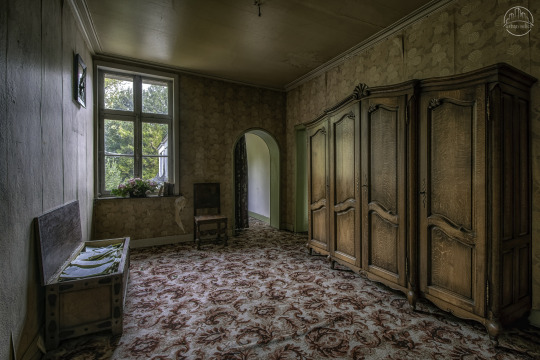
Nothing is known about the doctor and his family. The abundance of bedrooms and bathrooms suggests that a large family once lived here.
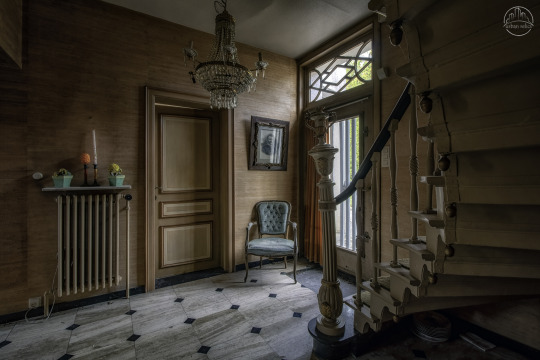

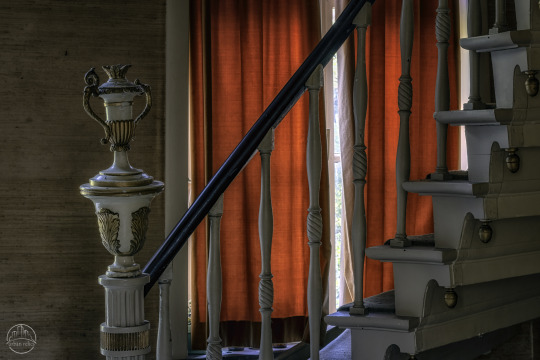

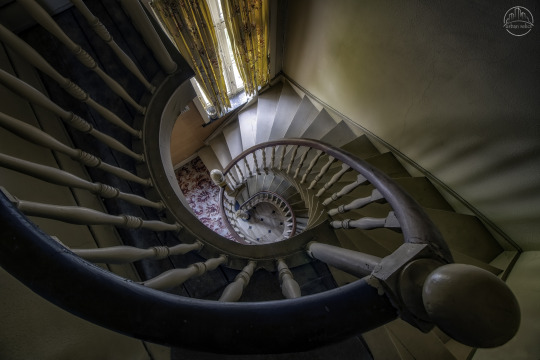
A beautiful hallway and staircase lead up to the second floor with the many bedrooms.
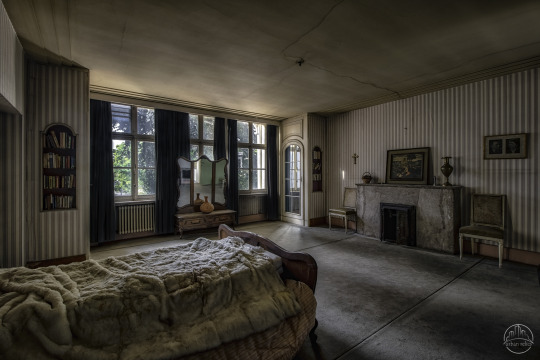
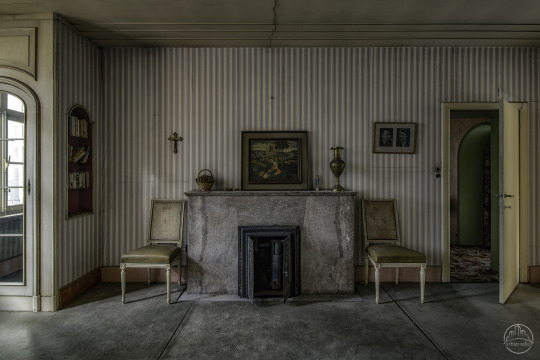
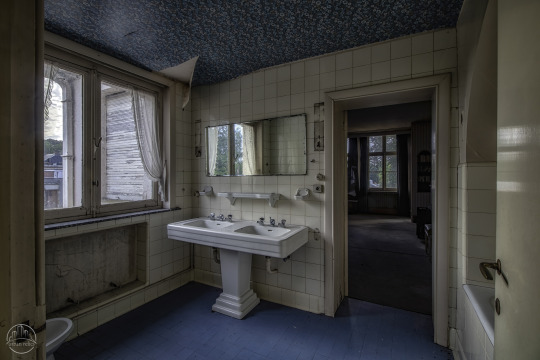
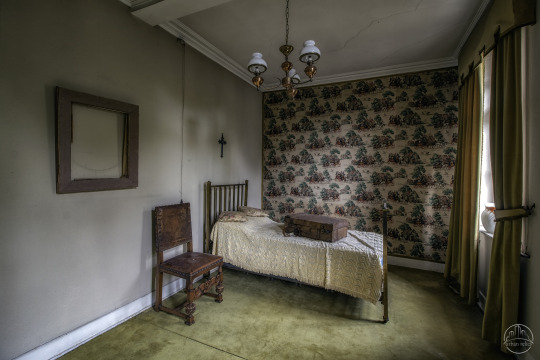
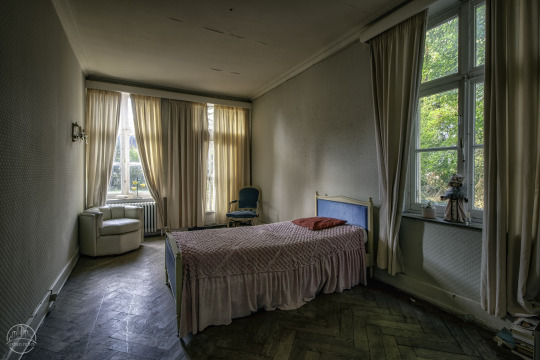
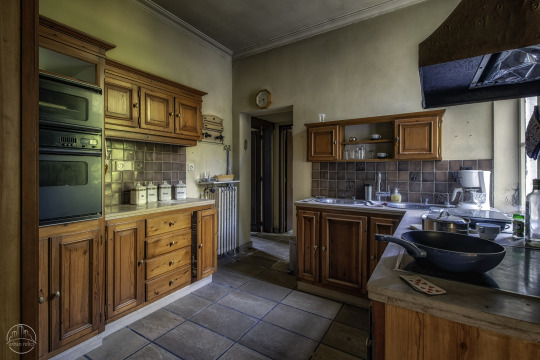

#urban exploration#urbex#abandoned#urban relics#decay#derelict#abandoned places#ue#photography#urbanexploration#residential#villa#docteur#abandoned addiction#abandoned house#abandoned buildings#lost places#belgium
75 notes
·
View notes
Text

SAPPHIRE CHURCH
Information about this abandoned church is extremely scarce. The church was built in 1877-1878, during the period when the city was experiencing enormous population growth due to the developing steel industry. During that period no fewer than 34 churches were built.

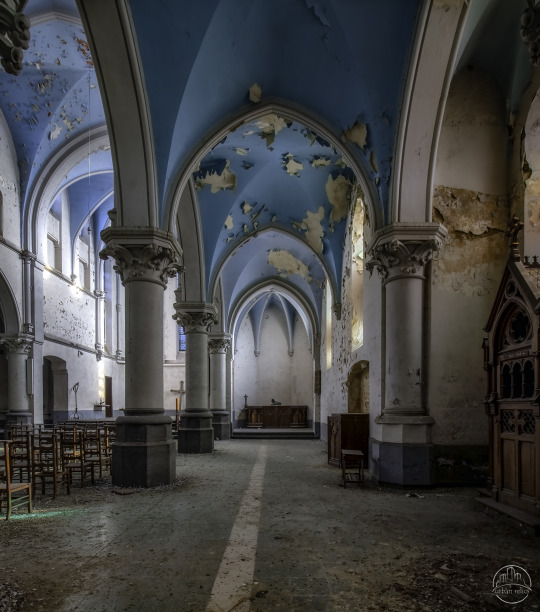

The church has a specatuclar blue vaulted ceiling, hence the name 'Sapphire Church'

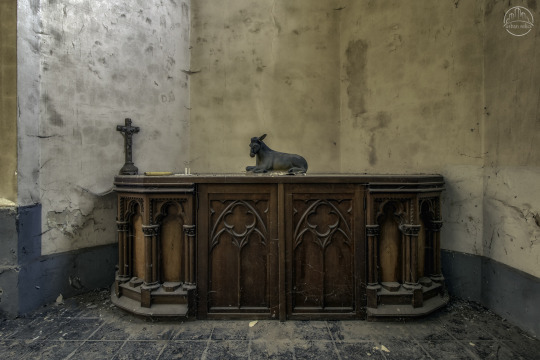

Along with the demise of the steel industry, the population also lost interest in Catholic worship. Many churches fell into disuse and some were even demolished. This church was desacralized in 2019 and sold to a private developer. It is not clear what the plans are.


The church is now showing critical signs of decay, which are beginning to affect the structure. Not very hopeful regarding the survival of this very beautiful building...

#urban exploration#urbex#abandoned#urban relics#decay#derelict#abandoned places#ue#photography#urbanexploration#religious#church#sapphire#blue#abandoned addiction#abandoned buildings#lost places#belgium
90 notes
·
View notes
Text

ENTREPOT DES ELEPHANTS
An abandoned warehouse is to an urban explorer like honey to a bee: irresistible. It often turns out to be an empty warehouse (which can also be nice). In other cases, the warehouse is filled with junk or completely vandalized. And very occasionally you bump into something you didn't expect at all... A collection of vintage cars, a rusty machine park,... or a bunch of elephants!
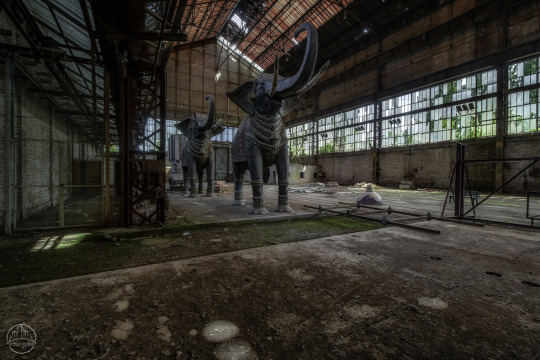
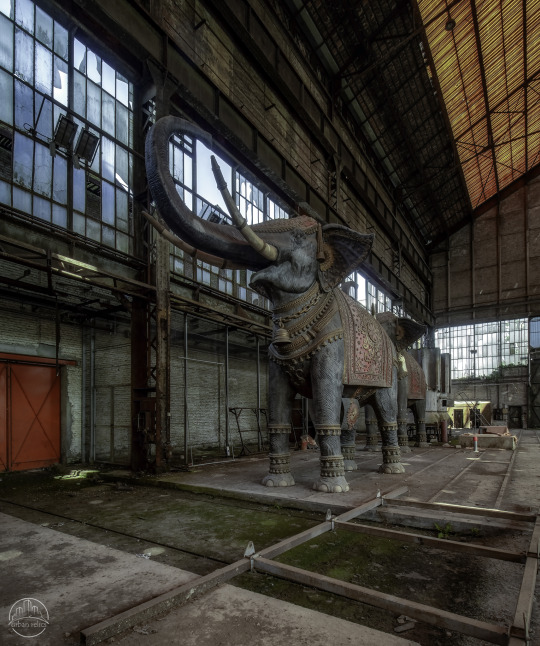
When Lille became "European Capital of Culture" in 2004, its activities and exhibitions attracted a tourist crowd that the town had never seen before. A few years later they tried to repeat that success with the creation of "Lille 3000"; a biennial cultural event around a specific theme. The first edition started with an international exhibition, with the rich Indian culture as its central theme. To add luster to the exhibition, 20 gigantic statues of colorfully decorated Indian elephants were brought over from India. These fiberglass elephants surrounding a metal frame were designed by one of Bollywood's most renowned film production designers, Nitin Chandrakant Desai. The 20 colossi were arranged in a kind of guard of honor along one of the city's main streets, which leads to the opera house.
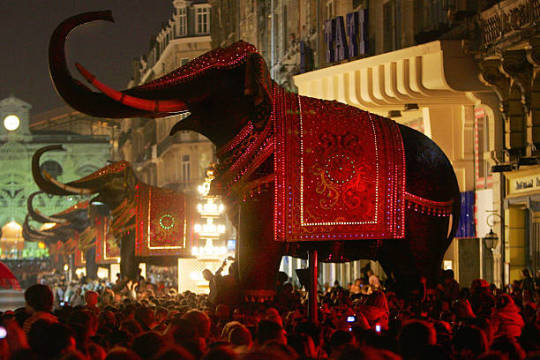

(Photo credit PHILIPPE HUGUEN/AFP via Getty Images)
From October 2006 to January 2007, the impressive colossi dominated the street scene. They were then disassembled and shipped to India. At least... 18 of the 20 returned to their home country. However, two elephants were left orphaned and are now in an abandoned shed, surrounded by some paraphernalia left behind after the city's Indian adventure...
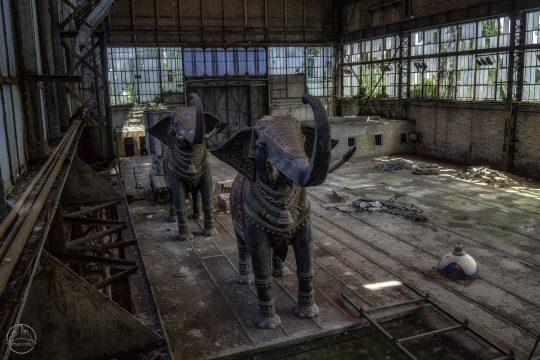
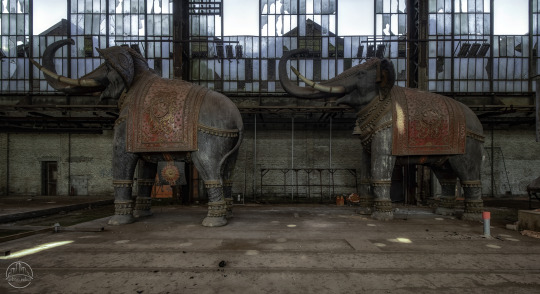
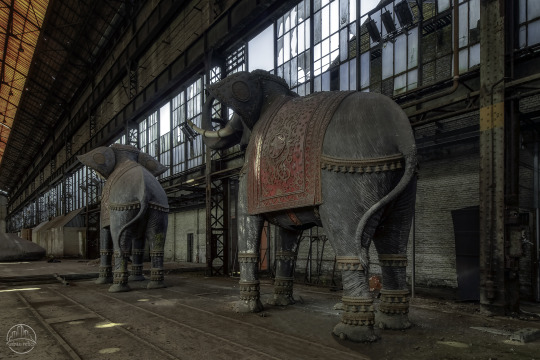
#urban exploration#urbex#abandoned#urban relics#decay#derelict#abandoned places#ue#photography#urbanexploration#abandophiles#abandoned buildings#urbexpeople#urbexplaces#urbexworld#urbexphotography#france
75 notes
·
View notes
Text

MOULIN DUCHESSE
'Remarkable' is the least you can say about this peculiar location. The buildings are filled almost to the brim with all kinds of old trinkets. In some places it looks a bit like a museum...

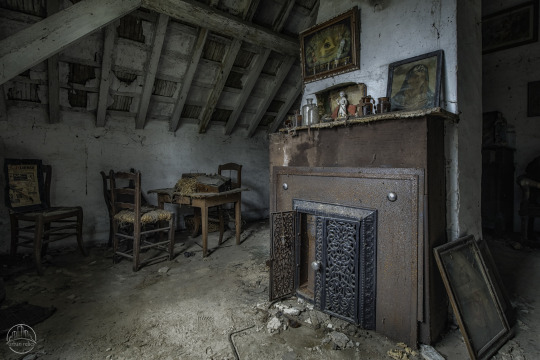
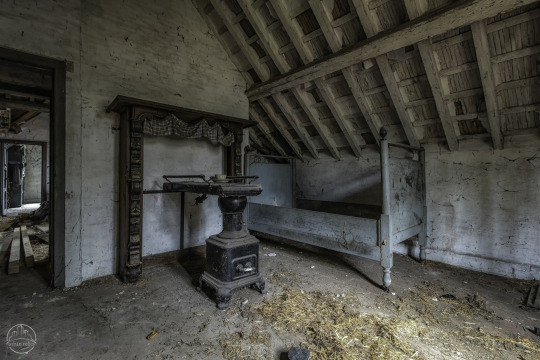
The history of this castle mill dates back to the beginning of the thirteenth century. However, at the end of the sixteenth century the mill fell into disrepair, partly as a result of the religious wars that raged during this period. It wasn't until around 1630 the mill was finally rebuilt. The construction of the water mill, this time in unsustainable wood and with a straw roof, took almost 8 years. Barely thirty years later it had to be rebuilt again, this time in brick and with a shale roof. This construction would last for more than 200 years.



At the end of the 19th century, the need to rebuild became apparent again. The current buildings largely date from this period. The entire mill complex was built in the same style and consists of the actual mill building followed by the miller's house. Behind this are the stables, the attics of which served as accommodation for the mulders' servants.
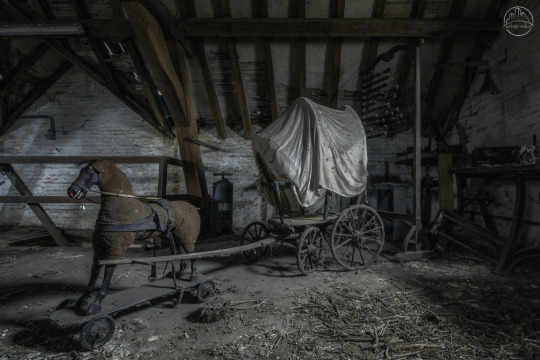



The last miller stopped grinding in 1963. Until then, the mill was used as a bakery mill, a farmer's mill and for personal use. The watermill has been silent ever since and has been remarkably well preserved (except for the waterwheel itself, which is missing several wooden blades).
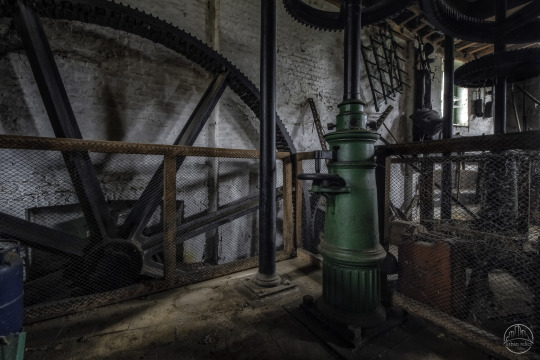


#urban exploration#urbex#abandoned#urban relics#decay#derelict#abandoned places#ue#photography#urbanexploration#urbexpeople#urbexphotography#urbexplaces#abandoned buildings#lost places#urbexworld#abandoned addiction#belgium
44 notes
·
View notes
Text
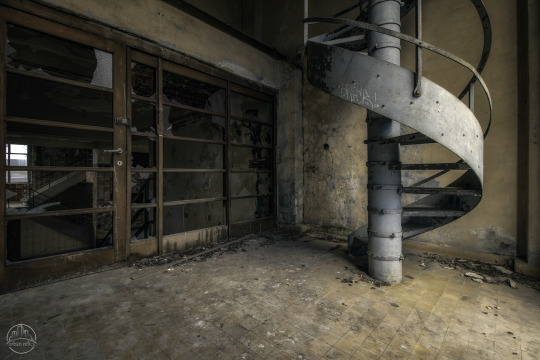
VAL BENOIT
The Val Benoit university site is an architectural complex in modernist style. It owes its name to the fact that an abbey of the Cistercian order was once located on this site. Founded in the 13th century, it was partly demolished as a result of the Liège Revolution. During the Second World War, what remained of it was destroyed by bombing.


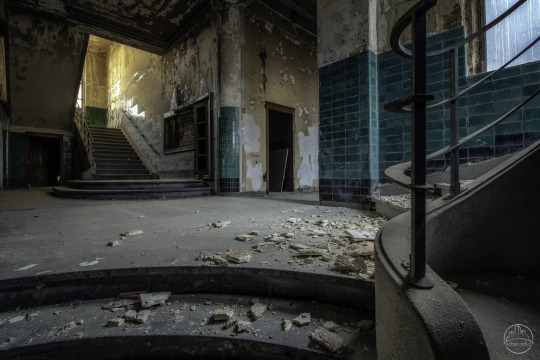
The majestic main entrance hall, with its many staricases seemingly leading everywhere is truly spectacular.



Between 1930 and 1965, the University of Liège looked for expansion opportunities due to the increase in students. That is why she built a number of new faculties here. This institute for applied chemistry and metallurgy was one of them. The building was inaugurated in 1937 in the presence of Leopold III. From 1967 onwards, the university systematically moved to the new, central site in Sart-Tilman.
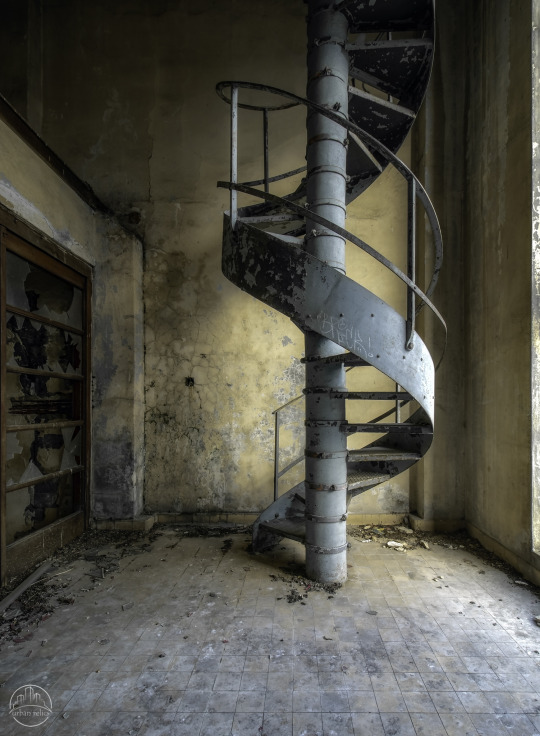
As of 2006, the Val Benoit campus was completely abandoned. Since 2013, works have been underway to rehabilitate the entire campus. Part will be occupied by companies and another part will be converted into student housing.
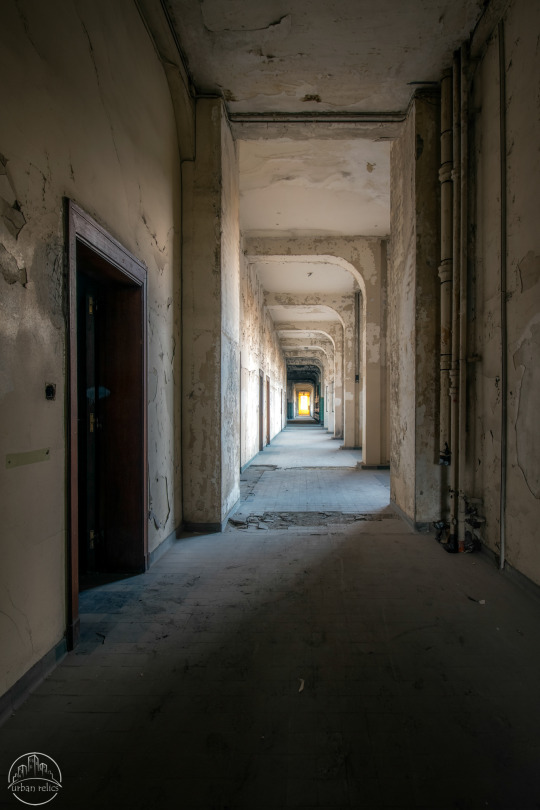


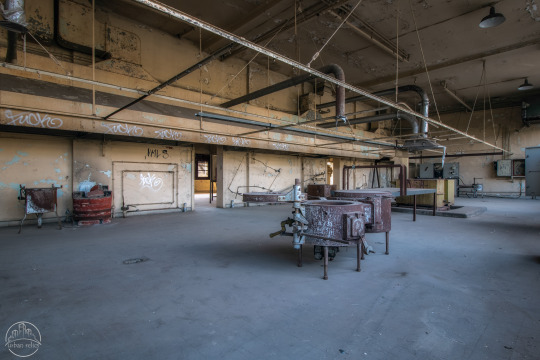
#urban exploration#urbex#abandoned#urban relics#decay#derelict#abandoned places#ue#photography#urbanexploration#urbexpeople#urbexplaces#urbexworld#urbexphotography#education#abandoned addiction#abandoned buildings#university#val benoit#belgium
101 notes
·
View notes
Text

ALIENWORKS
Abandoned steelworks power plant.
This iron and steel factory is a former blast furnace cast iron factory, built in 1890 by a German family business. The factory specialized in the production of pig iron, made from local iron ore.



Thanks to the company's continuous modernization, its ideal location in the French steel basin and the restructuring of the steel industry, the company concentrated its entire production of French cast iron in the mid-1960s.


Despite all these favorable criteria and technical innovations, the company, like all other steel companies, suffered seriously from the crisis in the steel industry in the 1970s. The company managed to survive for a while, but was forced to announce its closure in the early 1990s.

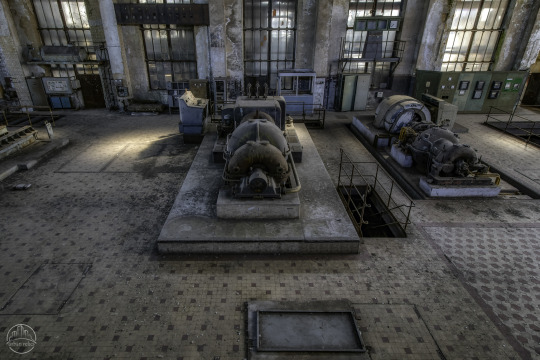
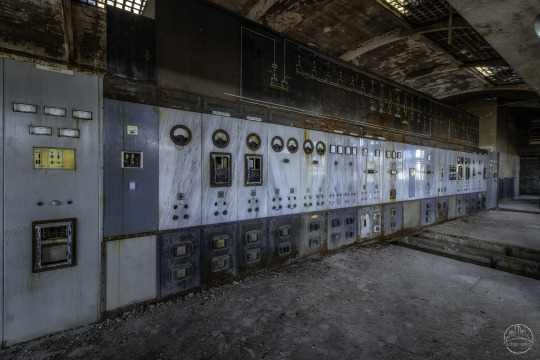

Part of the site, including the blast furnace itself, was preserved as industrial heritage.
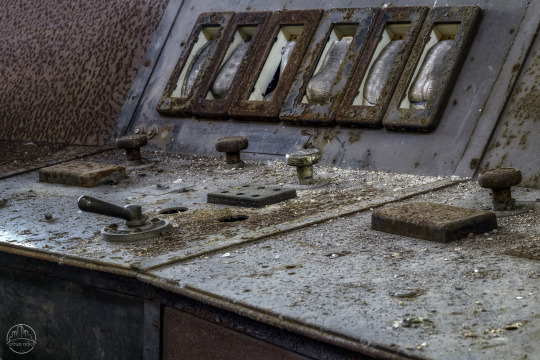

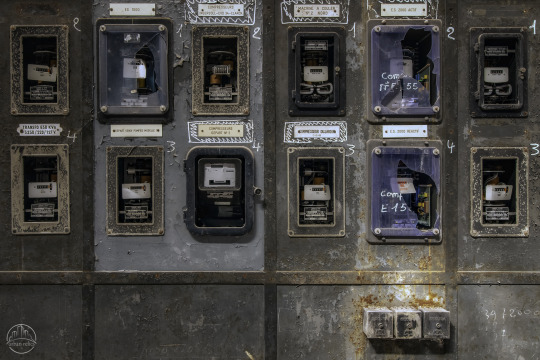
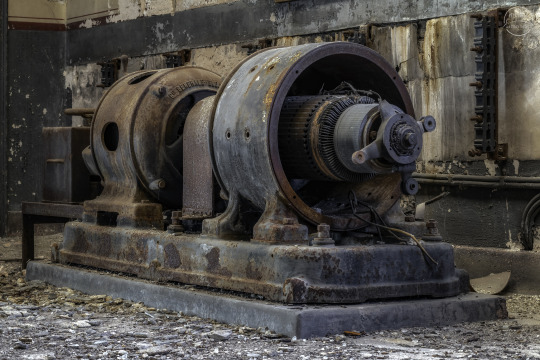
In this series of photos you see the power plant that was part of the blast furnace company. It is a classic power plant, with turbines from Brown Boveri and AEG, among others, driven by steam that was produced in the adjacent boiler room.
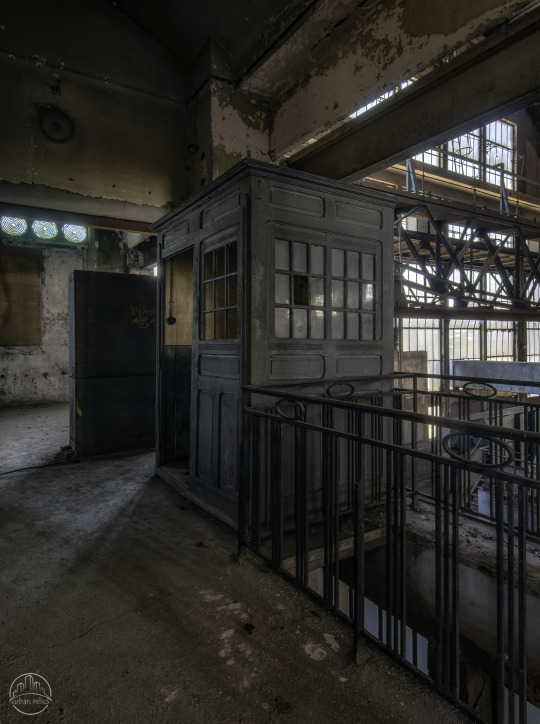


The site is well secured and difficult to access, which also explains why it has been preserved in its current beautiful state.

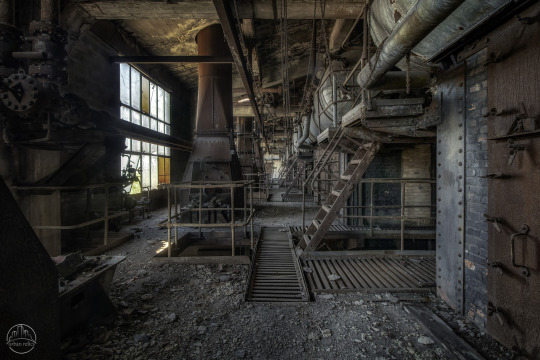

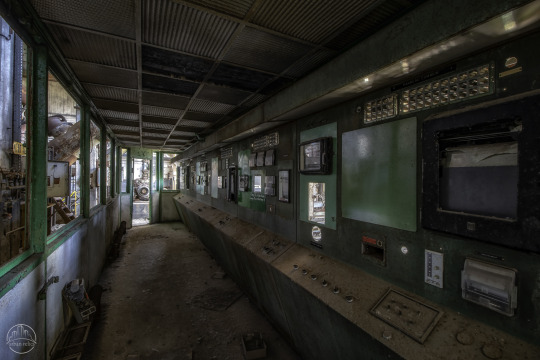
#urban exploration#urbex#abandoned#urban relics#decay#derelict#abandoned places#ue#urbexworld#urbexplaces#urbexphotography#abandoned buildings#industry#industrial#factory#power plant#alienworks#abandoned addiction#urbexpeople#france
72 notes
·
View notes
Text
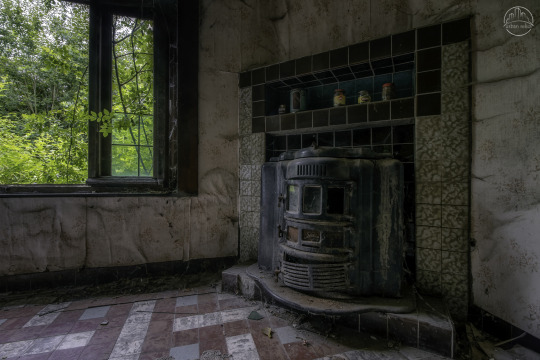
TAPIOCA FARM
Abandoned farm.
Tapioca Farm, aptly named so due to the presence of lots of tapioca in the kitchen cabinets, is arguably one of the oldest locations in urban exploring terms. The old farm has been abandoned for decades, but is still going strong!
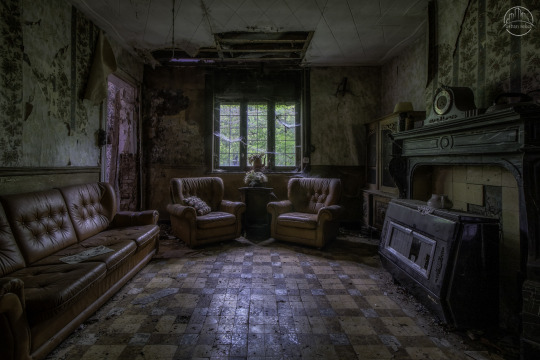

For some reason, this picturesque farm has been spared from thieves and vandals. That in itself is remarkable in the current urbex scene.


Even though it was spared from the visits of people with bad intentions, natural decay continues steadily. The building has had to withstand so much moisture and mold that restoration is no longer an option.



Why it was abandoned in the first place and why nobody is looking out for it after all these years, I could not tell you. I wasn't able to find any information on the buildings' history or its previous owners...
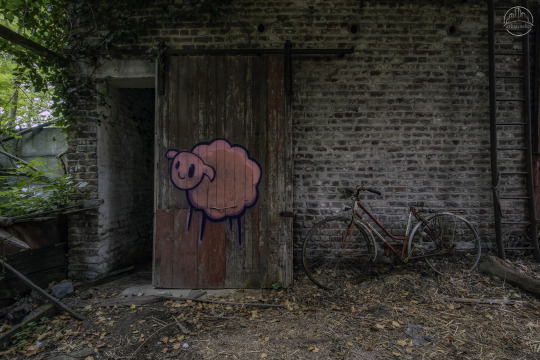
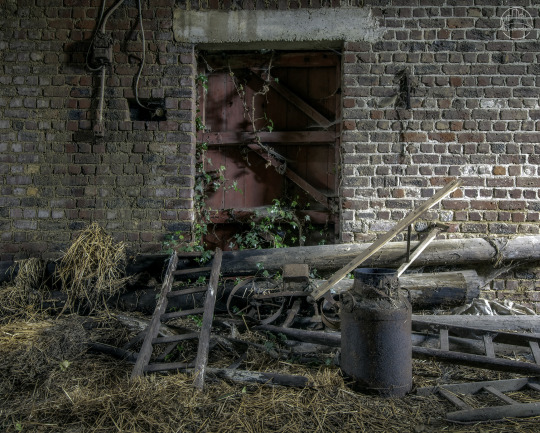
#urban exploration#urbex#abandoned#urban relics#decay#derelict#abandoned places#ue#photography#urbanexploration#urbexworld#urbexphotography#urbexplaces#urbexpeople#abandoned addiction#abandoned buildings#belgium
90 notes
·
View notes
Text

HASARD CHERATTE REVISITED
I visited this abandoned coal mine seven years ago. It was one of my very first explores of an industrial site. The steep descent to enter the site immediately brought back a lot of memories... You can watch the result of that first visit here: Hasard Cheratte OG. The site itself has since changed considerably...

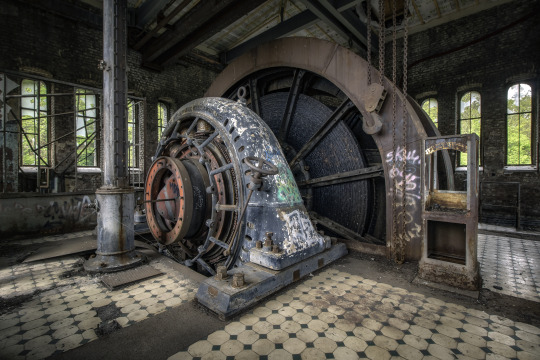
The contraption you see on the photos above, is in fact the turbine that hoisted the elevator out of the mine shaft. For some reason I didn't make it to the top level on my first visit, so I made sure to climb all the way up this time. And boy, was it worth it...
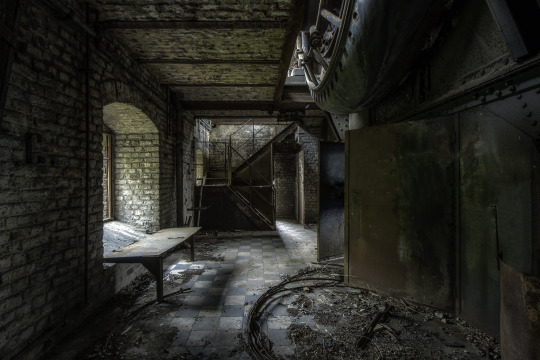

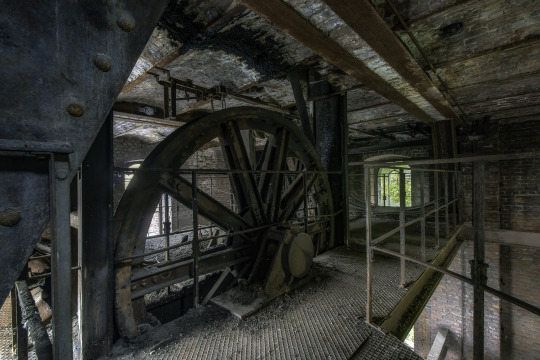
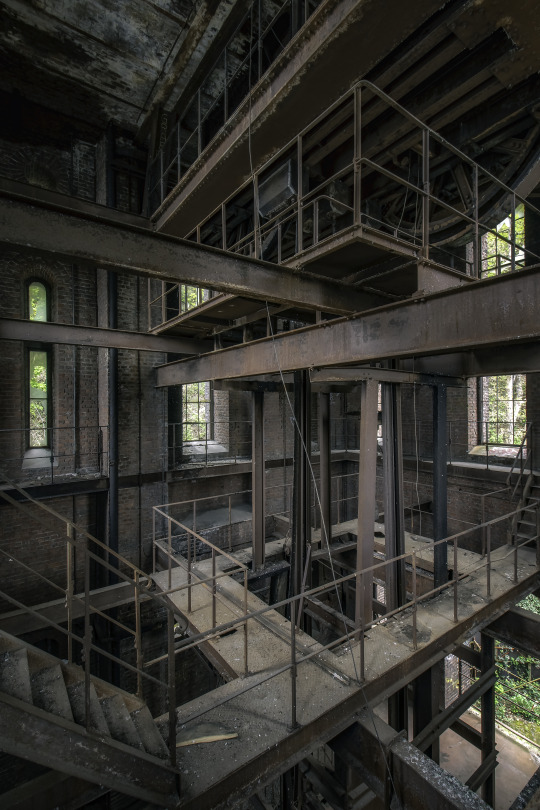

Shortly after the mine closed in 1977, the site was purchased for next to nothing by the Flemish industrialist Armand Lowie. He almost immediately started dismantling the old coal mine. Some of the old mining machines irrevocably disappeared into the scrap metal... Fortunately, the Walloon government intervened quickly and protected a number of the buildings and their contents. This unleashed a polemic between the new owner and the Walloon government that had lasted almost thirty years. From that moment on, nothing moved on the site at all. No more demolition works, but also no attempt at reconversion or restoration of the remaining buildings. Only deterioration and decay...

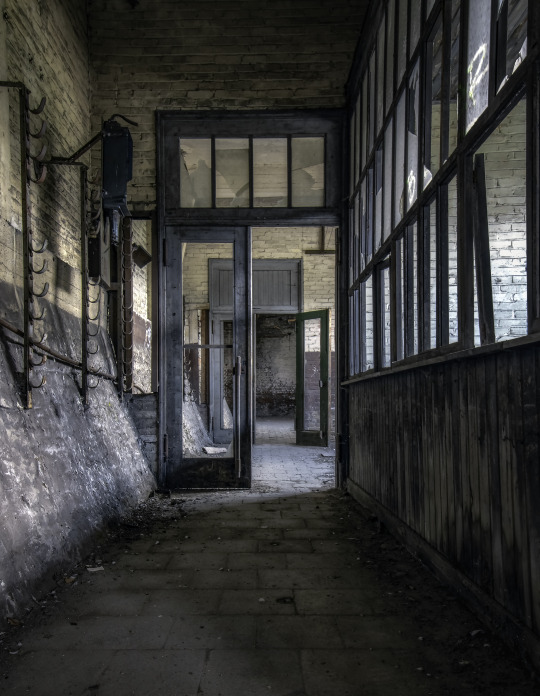

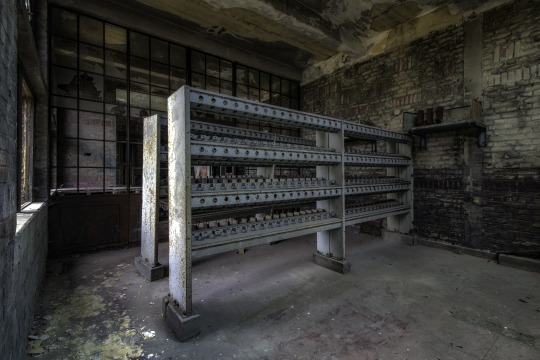
At the beginning of 2012, Armand Lowie died unexpectedly and Hasard Cheratte once again returned to the Walloon government after expropriation. Barely a year later, a remediation plan was proposed, in which the now protected buildings would be retained and the rest demolished. From 2017 - about a year after my first visit - the remediation works started, starting with the removal of asbestos and the demolition of the extraction tower of shaft no. 3. A scaffolding was built around the listed buildings of shaft no. 1, suggesting that the restoration work were taken seriously.


As suddenly as they started, the restoration work came to an end. The scaffolding disappeared, as did every activity on the site. At the time of my second visit, there is precious little sign of new life for the beautiful mine site...
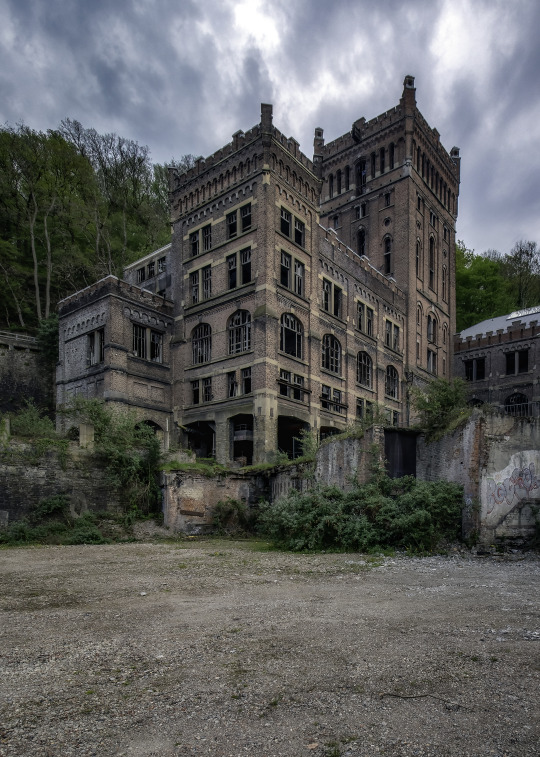
#urban exploration#urbex#abandoned#urban relics#decay#derelict#abandoned places#photography#urbanexploration#ue#urbexpeople#urbexplaces#urbexworld#abandoned buildings#lost places#urbexphotography#hasard cheratte#belgium
45 notes
·
View notes
Text
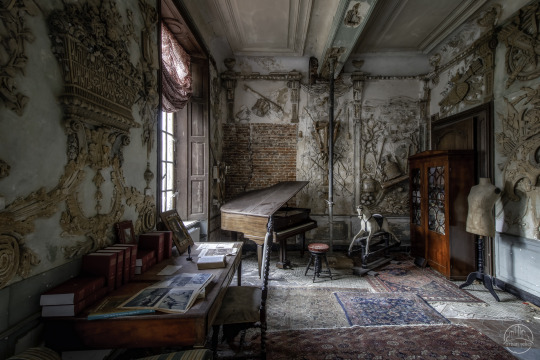
CHAPELIER FOU
The castle and adjacent farm were founded in the early 1630s by a scion of a noble family. The estate then extended over more than 500 hectares. The lord of the castle, a count, marquis and - in this village - a baron, was a well-known soldier during the Spanish Netherlands. He lived in the castle with his family until his death in 1655.
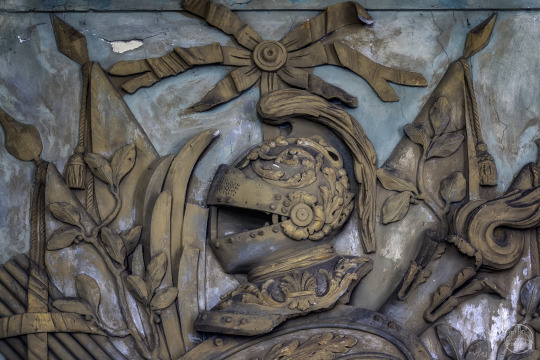
The lord's military background is still very prominent today in the armory with remarkable stucco decorations, representing military trophies, as well as plant and floral motifs.

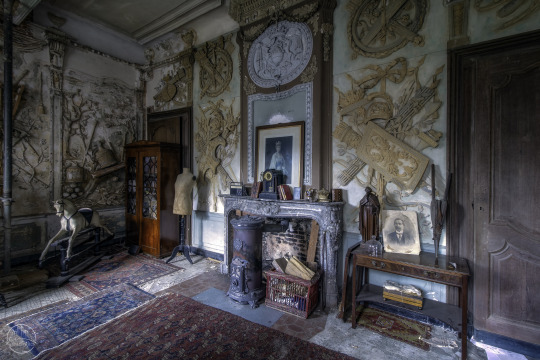
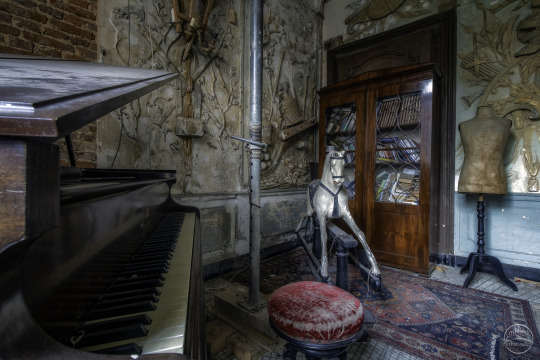
The castle is divided into two parts: the central part built by the count, consisting of a large living space formed by a long volume of ten bays. Later the two classic side wings were added at both ends. In the middle of the facade there is a monumental portico with a flattened spherical roof. On the tympanum the coats of arms of the counts, carved in sandstone, are still visible.

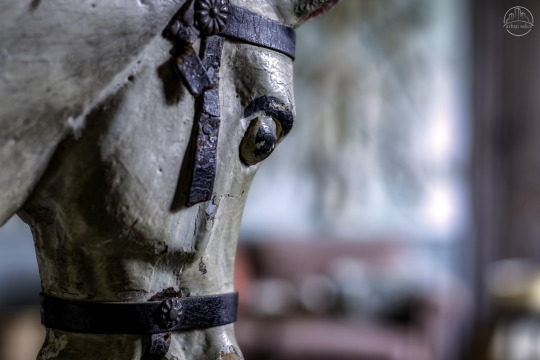

The castle has been left behind many years ago. To this day it is still filled with antique furniture and artefacts.

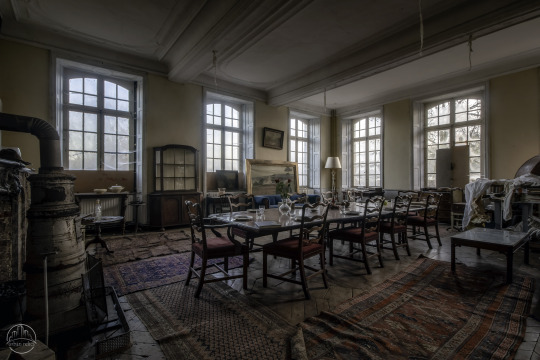

Unfortunately a lot has been stolen too...
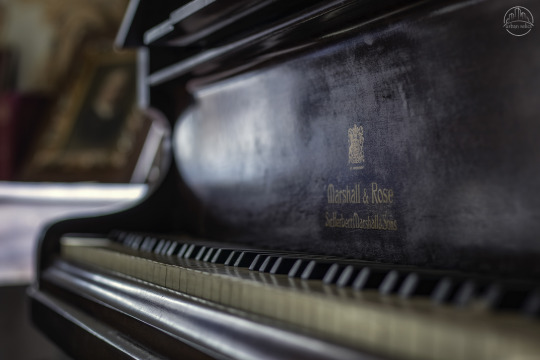
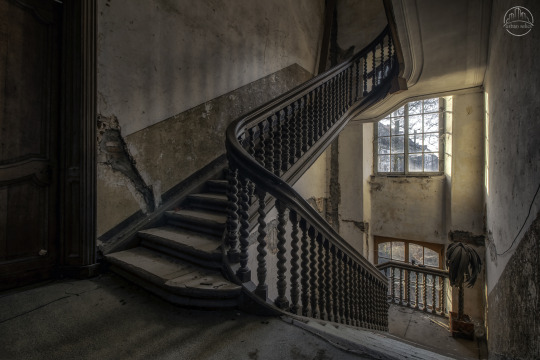


#urban exploration#urbex#abandoned#urban relics#decay#derelict#abandoned places#ue#photography#urbanexploration#abandophiles#abandoned addiction#chateau#chapelier fou#urbexpeople#urbexplaces#urbexworld#abandoned buildings#lost places#urbexphotography#belgium
107 notes
·
View notes
Text
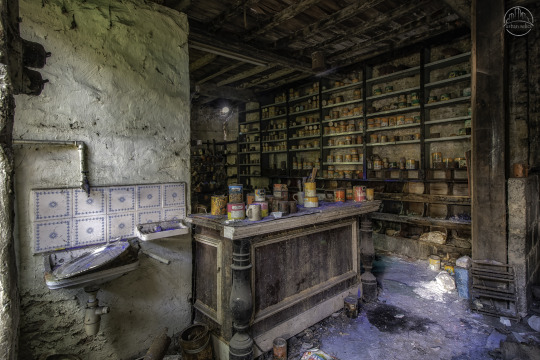
MAGASIN DE PEINTURE
From the outside view of this corner house, you wouldn't expect the huge property behind the facade. I wasn't able to find anything about the history of the building or its owners, but from what I saw it had clearly been a shop. At the back of the house I came across the cutest little paint shop... As is often the case with these old abandoned houses, that don't really have any architectural or historical value, it was torn down to make way for a new apartment building.




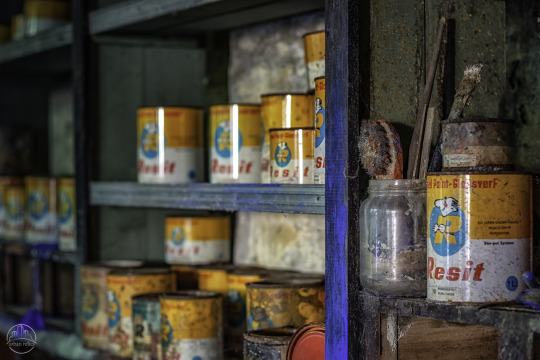

I am in general not the biggest fan of abandoned houses. Usually these places are quickly ransacked by thieves looking for valuables, followed closely by fake urbexers, who create all kinds of tasteless to downright ridiculous scenes in order to have supposedly "original photos". A set table (including filled wine glasses), a gracefully displayed dress or other trinkets, a pair of slippers placed in front of a chair, family photos fanned out on a side table... As if anyone in their right mind would dally up their house like that, just to promptly leave it all behind.
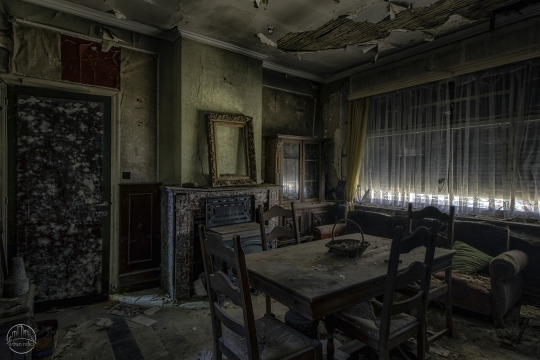




This house seems to have been relatively spared from all that nonsense. Probably also partly due to the fact that the floors in some of the rooms were in such a rotten state that they were no longer safe to walk on or had even already collapsed altogether...

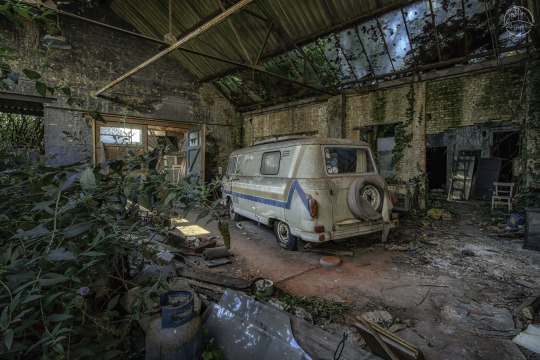


Behind the house and the paint shop I found a huge warehouse where the main feature was a beautifully preserved iconic Barkas van. All in all quite a fun explore...
#urban exploration#urbex#abandoned#urban relics#decay#derelict#abandoned places#ue#photography#urbanexploration#magasin de peinture#residential#paint shop#barkas#urbexpeople#urbexworld#urbexplaces#urbexphotography#abandoned house#belgium
17 notes
·
View notes
Text

FACTORY H
Factory H is one of three clustered buildings of the "Société Anonyme des Magazins à Grains d'Anvers" (SAMGA). SAMGA was founded in the mid-19th century for the storage, transhipment and trading of grains imported from America and Russia. Factory H can be found together with the other buildings (Factory F and Factory G) at the Amerikadok in the port of Antwerp.
Factory H is the second of these three buildings. The building was marked as architectural heritage. The remarkable grain silos were praised at home and abroad for their revolutionary techniques for treating grains.


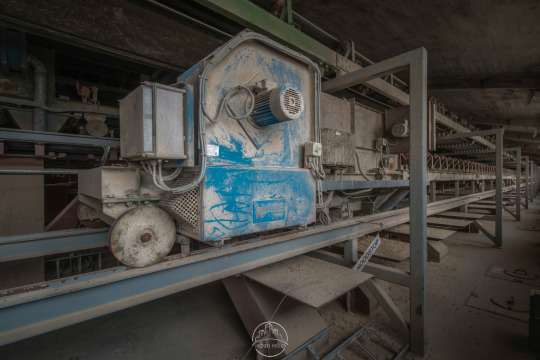

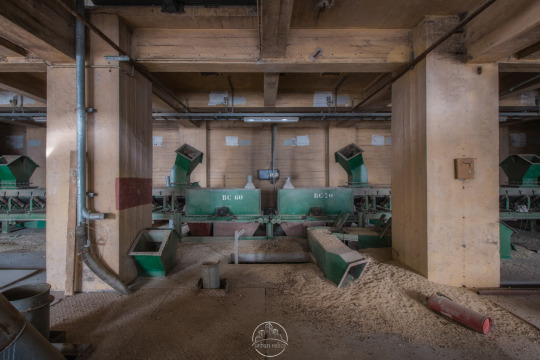

This particular building was erected in 1939, next to the original 1895 building. The building contains 115 silos. Together they can contain more than 27,000 tons of grain.


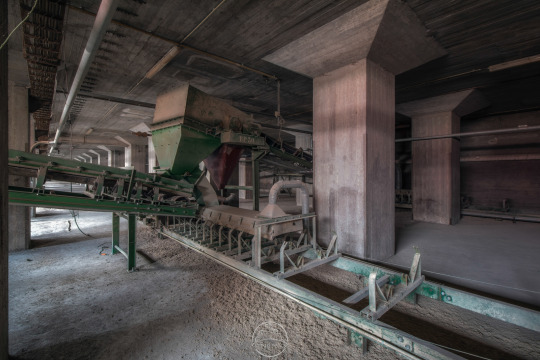


Despite the buildings being included as architectural heritage, the Antwerp municipal council decided to demolish them. The buildings had to make way for the construction of the "Oosterweel" connection, the megalomaniac highway project of the ever-attention-hungry mayor of Antwerp. Demolition of the building started in the spring of 2020. As a result, another magnificent piece of industrial heritage disappeared.

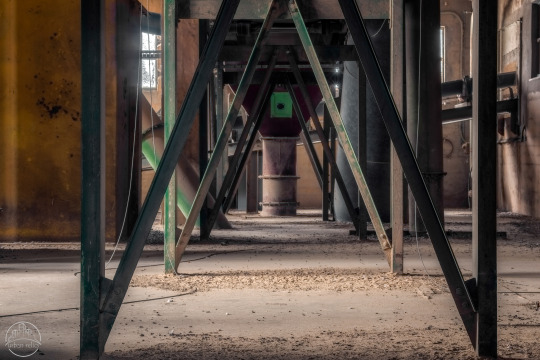


Sunset view of Factory H from the nearby offices of the Antwerp Port Authority. Factory H is the nearest building. Directly behind it is factory G, followed by the white tower of Factory F.

#urban exploration#urbex#abandoned#urban relics#decay#derelict#abandoned places#ue#photography#urbanexploration#urbexpeople#urbexworld#urbexplaces#urbexphotography#belgium#industry#industrial#industrial heritage
58 notes
·
View notes
Text
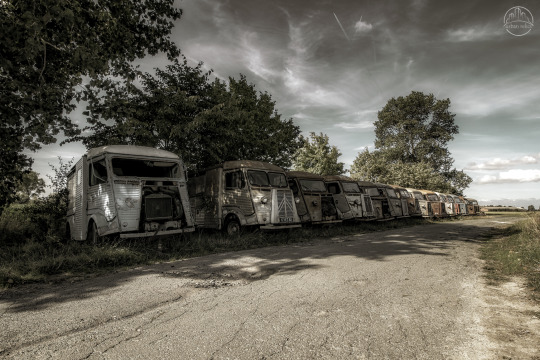
CITROËN H
Along a small dirt road, surrounded by meadows and fields, fourteen old Citroën vans of Type H and two 2CV vans of type AU are lined up next to each other. The vehicles were imported from France and were reportedly moved here to be restored and converted into food trucks...
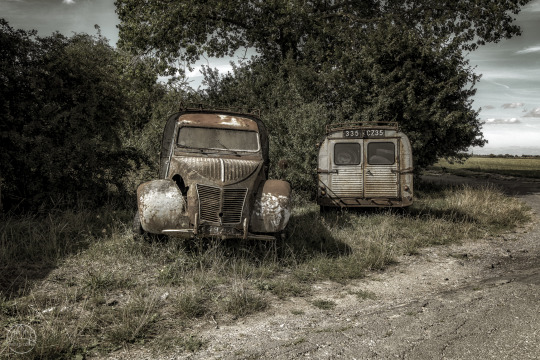

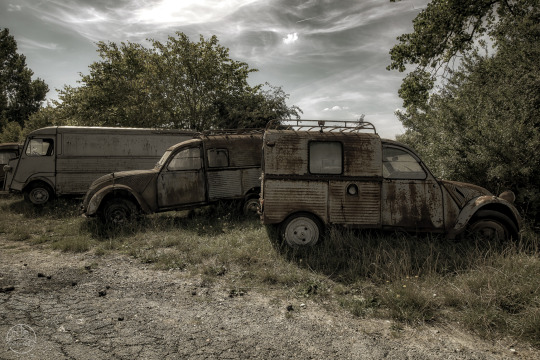
The two smaller 2CV AU vans were produced by Citroën from the early 1950s to the mid-1970s. It was the first small van with front-wheel drive. Due to the clear similarities with the 2CV (also called the "ugly duckling"), the model quickly gained cult status.

A few years earlier, more specifically in 1948, Citroën launched the Type H van; the first larger van with front-wheel drive. The van remained on the market for more than 30 years, until the early 1980s, without significant changes. Just like the 2CV van, the Type H quickly acquired cult status.



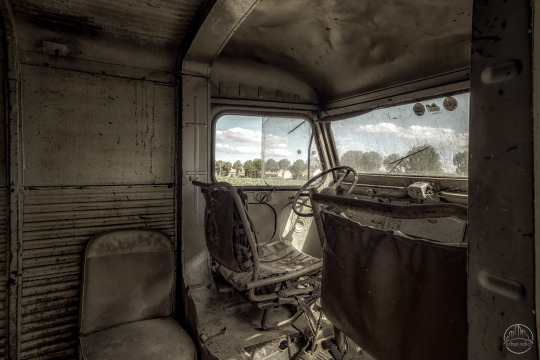


#urban exploration#urbex#abandoned#urban relics#decay#derelict#abandoned places#ue#photography#urbanexploration#transport#citroen#urbexpeople#urbexplaces#urbexworld#urbexphotography#belgium
64 notes
·
View notes
Text
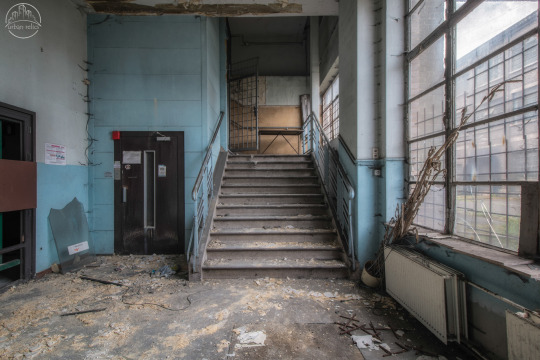
TRAINWORKS
The history of the Liège steel industry goes back further than the birth of Belgium in 1830. In 1817, the Englishman John Cockerill founded his first steelworks in Seraing to produce the steel for his looms. In the following decades, the steel industry develops to its peak, until it takes its first hits in the early 1980s. The majority of the steel activity in Liège and Charleroi is then brought together in Cockerill Sambre. Several blast furnaces, coking plants, coal mines, hot and cold rolling mills, factories for processing blast furnace slag,... dominated the Walloon economy for almost 200 years.
Various mergers and acquisitions attempted to revive the declining steel industry. When the Indian steel giant Mittal came on the scene in 2006 and took over Arcelor to form ArcelorMittal, the end was near. Numerous layoffs and austerity measures followed, much to the dismay of workers and unions. In 2013, after years of social unrest and negotiations, the curtain finally fell on the Liège steel industry. Some companies are still being placed "under cocoon", with the prospect of a potential restart, which unfortunately never comes...




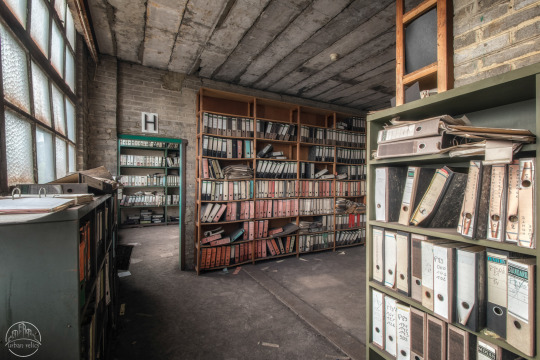

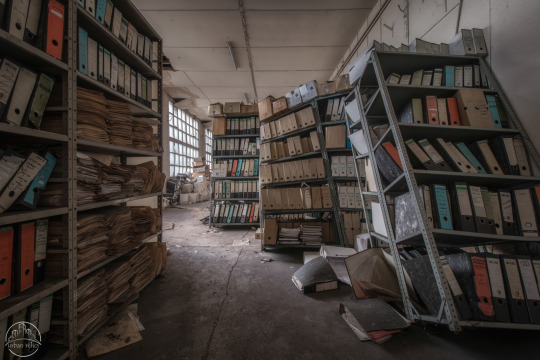

This site contains the administrative buildings, where the main administration of the steel company was located. The main building still contains a number of beautifully dilapidated offices and archives.



Apart from the administrative wing, there is also a large part of the site where there is a workshop where the company's trains were maintained and repaired. This part was mostly emptied.

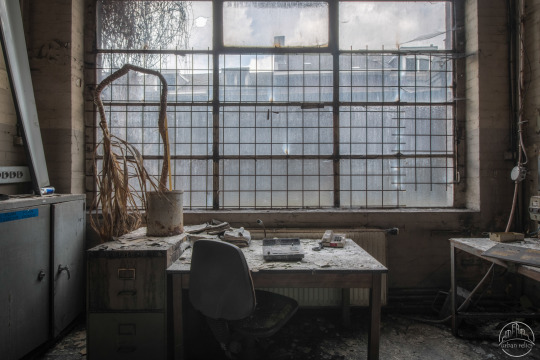
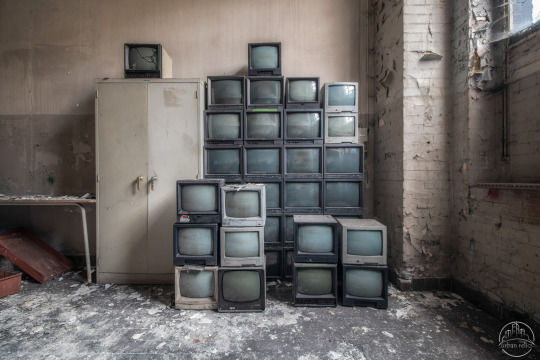



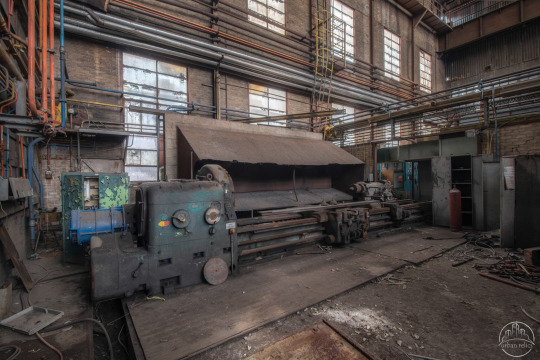
#urban exploration#urbex#abandoned#urban relics#decay#derelict#abandoned places#ue#photography#urbanexploration#steel industry#industrial#industry#urbexpeople#urbexplaces#urbexworld#urbexphotography#belgium#arcelormittal#liege
97 notes
·
View notes
Text
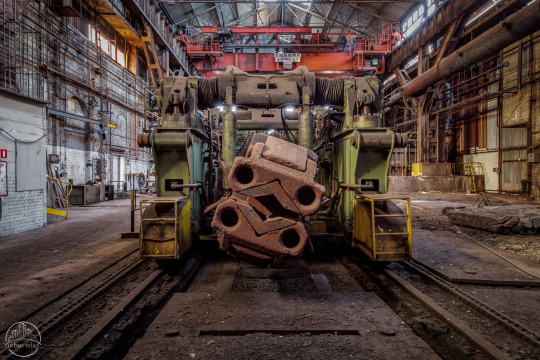
MASTERS OF STEEL
One of the many steelworks that fell victim to the crisis in the steel industry. This building, although usually regarded as a separate location in urbex centers, should in fact be seen together with 'Control Room S'. Both were initially part of one and the same power plant of the steel company Cockerill.


After Cockerill's activities ceased, the buildings were taken over by the Swedish steel company Akers, which produced cylinders for rolling mills. In the two photos above, however, you can still see the remaining Citroën turbines from the former power station.
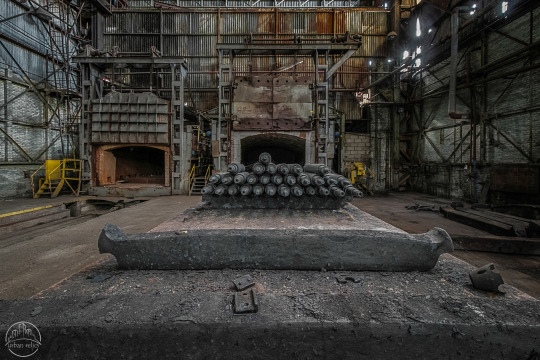

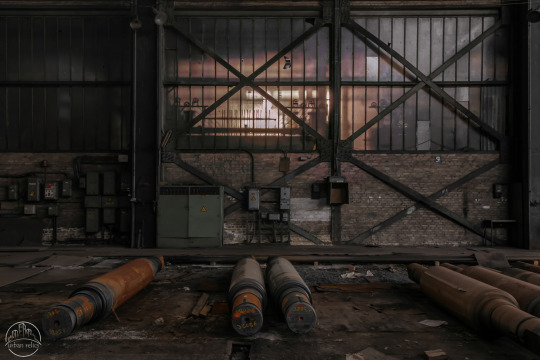



At the time of my visit there, it was a "dormant" company. It had not yet been officially or definitively discontinued. Production had been halted for a long time because the company could no longer pay the workers. Production could restart at any time.
Not long after my visit I learned that the company had permanently ceased operations. The factory has since been emptied, but the buildings are still standing. Since most industrial buildings in the area have been or are being demolished, it seems likely that these buildings will suffer the same fate.
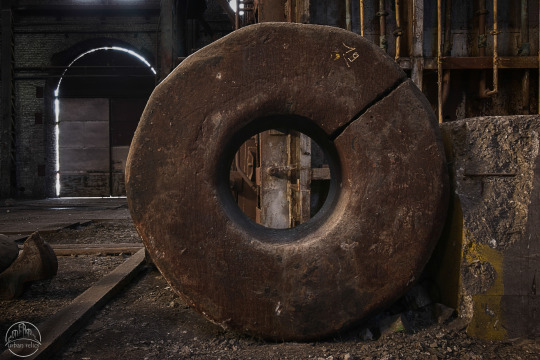

#urban exploration#urbex#abandoned#urban relics#decay#derelict#abandoned places#ue#photography#urbanexploration#industry#industrial#steel industry#industrial heritage#urbexpeople#urbexplaces#urbexworld#belgium
42 notes
·
View notes
Text
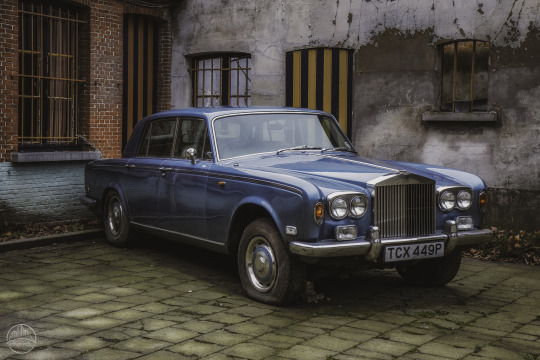
CHATEAU ROLLS ROYCE
The castle domain was created in the late 18th century. The wealthy notary A.S. started construction of the castle in 1780, originally consisting of a classicist main building, which was symmetrically flanked at the front by two lower, 19th-century side wings and several outbuildings, including a beautiful and almost unique winter garden.




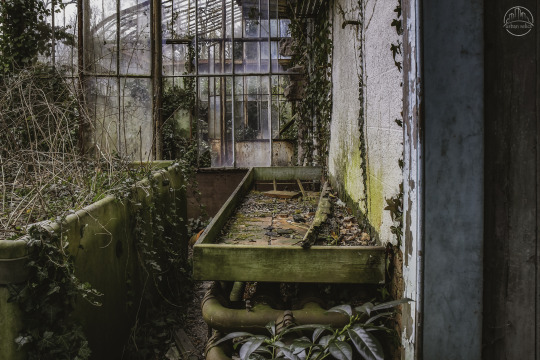
After the death of the notary, the property passed into the hands of his only son, who gave it significant added value by creating an English landscape garden. The surrounding park includes a pond with island and historic duck decoy, beautiful old woodland and a former ice house. When the son also died, the castle remained empty for a while. In 1831, the castle briefly served as the command post of Leopold I, first king of Belgium.
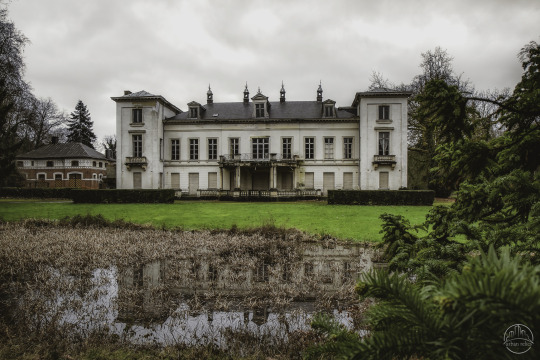

In 1859 the whole was sold to a baron, who used it as a summer residence. In 1909, a wealthy Antwerp banker buys the castle. He builds the two towers that flank the castle. The castle remained in the hands of this family until the mid-1950s. Today, the castle and park are owned by the Luxembourg real estate company, which wants to start a hotel there in the future.
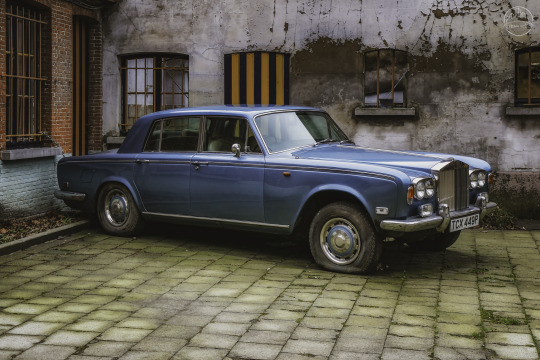
In the urbex scene, this chateau was known as 'Chateau Rolls Royce', for many years, because of the beautiful blue Rolls Royce Silver Shadow. Rolls Royce built the Silver Shadow between 1965 and 1979. At the time, it was the most expensive and luxurious model introduced by Rolls Royce. This particular car was built in 1975 and was first registered in January 1976, as one of the last variants of the model. The colossus, weighing more than two tons, was more than 5 meters long, 1.80 meters wide and had a cylinder capacity of 6,750 CC. It reached a top speed of 205 km/h without much effort.
#urban exploration#urbex#abandoned#urban relics#decay#derelict#abandoned places#ue#photography#urbanexploration#chateau#rolls royce#winter garden#silver shadow#belgium#abandophiles#abandoned addiction#urbexplaces#urbexphotography#urbexworld#urbexpeople
65 notes
·
View notes